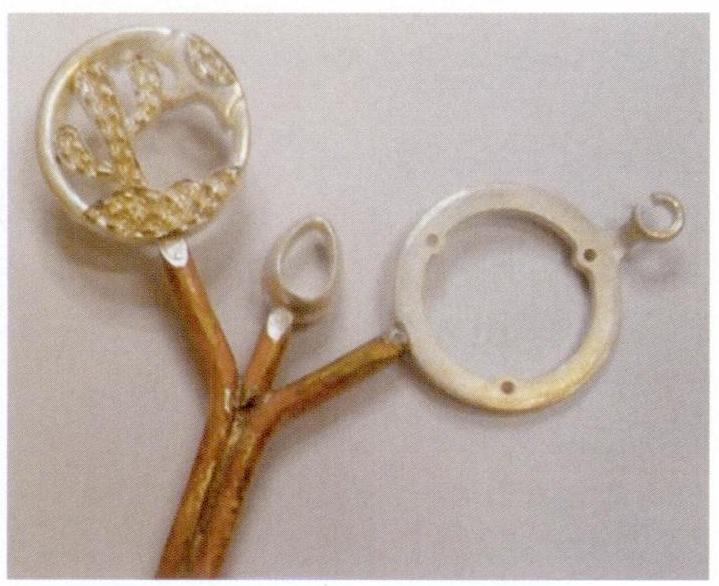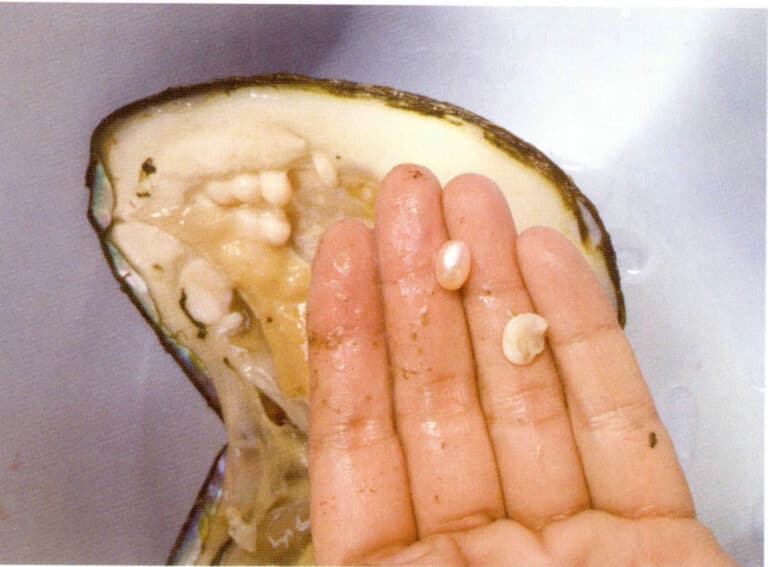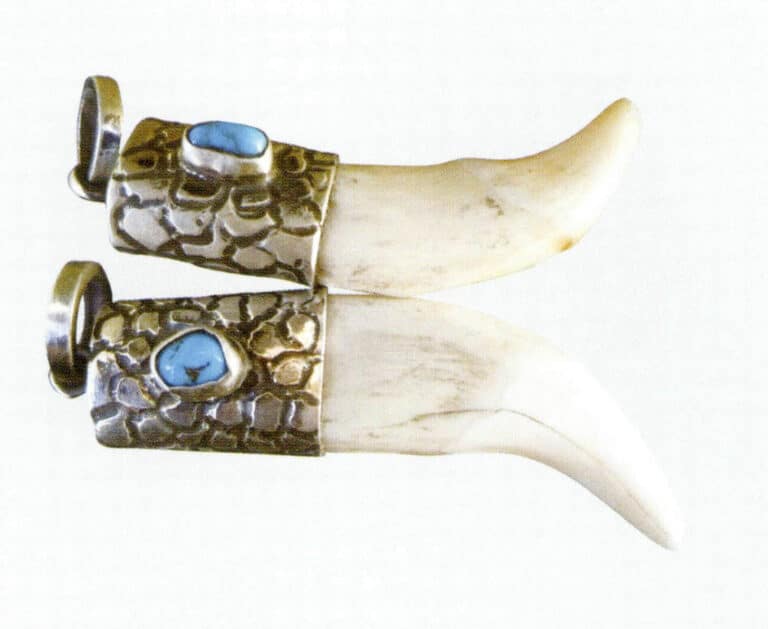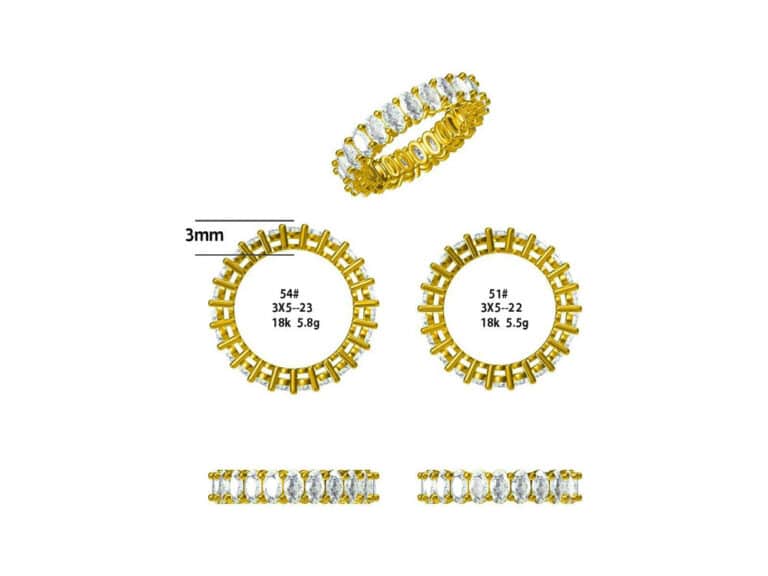Where To Find The World’s Largest Diamonds?
World's Largest Diamonds: Botswana, Sierra Leone, Lesotho & Global Mines
Wprowadzenie:
Have you ever wondered where the world’s largest diamonds originate and how they become legendary jewelry? This guide explores the journey of extraordinary rough diamonds, like the 1,758-carat Sewelô from Botswana and the 910-carat Lesotho Legend, from their discovery in African mines to their meticulous cutting and polishing. Learn about their D color, flawless clarity, and acquisition by renowned houses like Graff and Harry Winston. For jewelry designers, retailers, and brands, it provides essential insights into sourcing these rare gems for high-end custom pieces and exclusive collections.

Spis treści
Section I Extra-Large Diamonds Produced in Botswana
1. Rare Sewelô Diamond
(1) Naming of the Rare Sewelô Diamond
The Sewelô diamond, a rare find, was discovered on April 19, 2019, at the Karowe diamond mine in Botswana. The diamond weighed 1,758 ct, measured 83mm×62mm×46mm, had a very dark colour, and was roughly the size of a tennis ball (Fig. 5–27). The mine owner, Canadian company Lucara Diamond Corp, invited the people of Botswana to participate in naming it. Out of a total of 22,000 name submissions, “Sewelô” (which means “a rare find” in Setswana) was chosen and announced at a naming ceremony attended by the President of Botswana. This diamond is the largest found in Botswana and the second-largest known in the world, second only in weight to the Cullinan diamond.
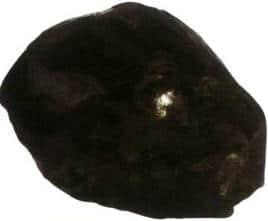
(2) Characteristics and Cutting of the Sewelô Diamond
From appearance, the diamond’s colour looks dark, but according to preliminary analysis, this diamond is gem-quality, containing high-quality white diamond material; a careful study of this diamond will continue for some time. The diamond’s surface is covered with a thin layer of carbon, giving it a black exterior, while the colour and clarity inside the diamond remain variable.
The world-famous luxury company Louis Vuitton announced it is collaborating with Lucara and Belgian Antwerp diamond manufacturer HB to cut and polish the rare Sewelô diamond into a gem-quality stone, whose “full potential” will only be revealed after polishing. This also reflects Louis Vuitton’s willingness to take risks and its creativity; this diamond is extremely rare, unconventional, challenging, and extraordinary.
Louis Vuitton is working closely with the Antwerp diamond manufacturer to study the diamond’s details and is using the latest scanning and imaging technologies to evaluate the diamond’s final cutting plan, with the goal of producing the largest yield and the best polished-cut quality. The first step in cutting is to grind a window into the diamond so the internal features can be observed and the cut’s shape, size, and colour range can be designed. Diamond cutting is an ancient, almost mystical art that combines technology, expertise, and intuition. Advanced cutting-edge technology will play a critical role throughout the entire process, from initial scanning and design to cutting and polishing, which is estimated to take a year to complete.
2. Lesedi La Rona Diamond
(1) The Discovery of the Lesedi La Rona Diamond
The Lesedi La Rona diamond was discovered in November 2015 at the Karowe diamond mine in Botswana, weighing 1109ct. Lucara Diamond Corp., headquartered in Canada, owns this diamond. The diamond measured (Fig. 5–28) 65mm×56mm×40mm, its clear, sparkling appearance about the size of a tennis ball. This was the first giant diamond over 1,000 ct found in more than a century since the Cullinan diamond. Diamond analysts estimated its value at several tens of millions of dollars. “Lesedi La Rona” in Tswana means “Our Light,” implying that the diamond is Botswana’s pride, light, and hope.

(2) The Cutting of the Lesedi La Rona Diamond
After gemologists and the diamond-cutting team conducted a careful study, analysis, cutting, and polishing—taking a total of 18 months and based on computer-simulated cutting—from this exceptionally large rough diamond, they produced one large diamond and 66 finished stones.
The largest of these was named the “Graff Lesedi La Rona” diamond (Figure 5–29), weighing 302.37ct, cut in a square emerald-cut style, which is the largest diamond of this cut in the world to date. The Gemological Institute of America (GIA) assigned the diamond a colour grade of, with extremely high clarity and excellent polish and symmetry.
Every finished diamond cut from the Lesedi La Rona rough diamonds has been tested and graded by GIA, with a colour grade of D. Each diamond has “Graff” and “Lesedi La Rona” and its exclusive GIA number (Figure 5-30) laser-engraved on the girdle .
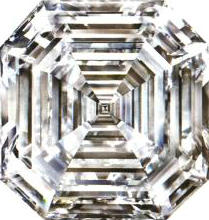
Figure 5-29 Graff ·Lesedi La Rona diamond

Figure 5-30 Finished diamond with inscription on the girdle
3. The Constellation Diamond
(1) Discovery and Ownership of the Constellation Diamond
The Constellation diamond was discovered in November 2015 at the Karowe diamond mine in Botswana. It weighed 813 ct and measured up to 60 mm across, with excellent colour and clarity (Fig. 5–31). In May 2016, after intense auction bidding, it was purchased for $63 million by Switzerland’s De Grisogono in partnership with Dubai’s Nemesis International. The price per carat was about $77,613, making it the most expensive rough diamond ever sold.

(2) Cutting of the Constellation Diamond
Fawaz Gruosi, founder and board member of de Grisogono, said: “Encountering a Constellation diamond is a once-in-a-lifetime event that thrills me beyond words. As a jewellery designer, I could never betray this famed diamond or the team colleagues who worked hard to win this gem; it is a great honour to be able to incorporate my creative skills into the diamond’s cutting and setting, and I cannot wait to begin creating.”
The De Griscons Company’s purchase of this diamond can help reinforce the advantages of promoting and selling top-tier diamonds, demonstrate its determination to collect the world’s rare gemstones and create jewellery masterpieces, and thereby showcase its brand image. The company can participate directly in the cutting process of this precious diamond, combining its unique creativity and exquisite craftsmanship to make a once-in-a-lifetime treasure for clients.
The cutting of the Constellation Diamond was completed at Nemesis’s affiliate Almas Diamond Services and took 18 months in total. Eight finished diamonds were cut from this rough stone, the largest of which weighs 313 ct (Fig. 5–32), is D colour, and has a clarity of VVS1. The second-largest diamond weighed 102 ct.
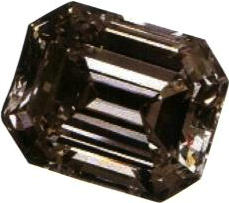
4. An Still-Unnamed Giant Diamond
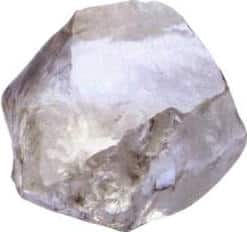
5. The Mysterious, Unnamed, Very Large Diamond

Section II Exceptionally Large Diamonds Produced by Sierra Leone
1. The Sierra Leone Star Diamond
(1) Discovery of the Star of Sierra Leone Diamond
The Star of Sierra Leone diamond was discovered on February 14, 1972, by a Sierra Leonean, E. O. Williams, in alluvial deposits at Diminco, Koidu town, Kono district, Eastern Province, Sierra Leone. At the time of discovery, it was the third-largest known natural diamond in the world, weighing 969.80 ct (Fig. 5-35). The diamond was clean, irregularly shaped, and classified as a single type IIa diamond.

(2) Cutting and Polishing of the Star of Sierra Leone Diamond
On October 3, 1972, then President of Sierra Leone, Siaka Probyn Stevens, announced that the famous American jeweller Harry Winston had purchased the Star of Sierra Leone diamond for $2.5 million. The diamond was initially cut into a single finished stone weighing 143.20 ct in an emerald cut; because of internal flaws, it was subsequently recut. The Star of Sierra Leone was cut into a total of 17 finished diamonds, 13 of which were flawless; the largest finished diamond weighed 53.96 ct, had flawless clarity, and was pear-shaped. Six finished diamonds cut from this rough were later set by Harry Winston into the Star of Sierra Leone brooch.
2. Woyie River Diamond
The Woyie River diamond, also from Sierra Leone, is a large, snow-white diamond weighing 770.00 ct. It was discovered in 1945 in the alluvial deposits of the Woyie River in Sierra Leone. This diamond-bearing river also yielded two other diamonds weighing 532.00 ct and 249.50 ct respectively; the diamonds were transported by river from distant primary sources, but the original primary deposits have not yet been found. The Woyie River diamond was cut in London by Briefel and Lemer, producing a total of 30 diamonds, the largest weighing 31.35 ct with an emerald cut, named the Victory Diamond (Figure 5-36).
According to an evaluation by the Gemological Institute of America (GIA), this diamond is graded D in colour with VVS2 clarity. In December 2015, it was auctioned at Christie’s in New York, selling for $4,039,000.

3. The Peace Diamond
(1) Discovery of the Peace Diamond
The Peace diamond, discovered in March 2017 in the Koryardu alluvial mine in the Kono district of eastern Sierra Leone, weighed 709.41 ct (Fig. 5-37). The egg-sized diamond was recovered by five miners with the assistance of Pastor Emmanuel Momoh.

(2) The Auction of the Peace Diamond
In December 2017, the Government of Sierra Leone publicly auctioned the diamond for the first time, attracting more than 70 potential buyers. After seven rounds of bidding, it was finally won by British jeweller Laurence Graff for a price of US$6.5 million. Fifty-nine percent of the proceeds from the auction were deposited into Sierra Leone’s treasury to help improve infrastructure in the diamond-producing areas and provide residents with clean drinking water and safe medical care. This auction will encourage miners to hand their mined diamonds over to the government for public auction rather than selling them on the black market; “this could be the beginning of a new era for Sierra Leone.”
Laurence Graff, who won the bid for the diamond, said: “We are very honored to have acquired this extraordinary diamond; this transaction will directly benefit Sierra Leone, which is in urgent need of assistance. Being able to give back to the regions that produce these beautiful gems is especially meaningful. Every beautiful diamond we encounter reflects our immense passion and professional expertise. Now, Graff’s gemologists will begin evaluating the diamond to uncover the hidden beauty of this natural wonder.”
4. The Sefadu Diamond
5. The Maya Prosperity Diamond
(1) The Discovery of the Meya Prosperity Diamond
The Meya Prosperity diamond was discovered in 2017 at the Meya mine in the Kono district of eastern Sierra Leone. The rough stone weighed 476 ct (Fig. 5-38). The discovery of this diamond opened a bright future for the local area and will bring significant changes and development opportunities to the country.
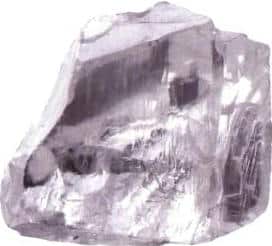
(2) The Transaction of the Meya Prosperity Diamond
Jan Joubert, CEO of Meya Mining, said: “We are delighted to have reached an agreement with Laurence Graff to sell the ‘Meya Prosperity’ diamond. Under his wise leadership who has owned countless rare and beautiful diamond can a perfect story for this rough stone. Our partner must understand our core values and vision, namely, high transparency, accountability, and integrity. And Graff is the obvious choice.”
In 2017, Laurence Graff bought “Lesedi La Rona,” “Peace,” “Meya Prosperity,” and a 373ct rough diamond. He noted, “Graff bought four of the most important diamonds in history this year, and we are very honoured to be entrusted with safeguarding these rare treasures. Now Graff’s team of experts will devote themselves to studying the Meya Prosperity diamond, striving to unlock the potential of this wonder. We will consider every step carefully, as we do with other legendary gems. Over the coming months, we will decide on the cutting and polishing methods for these precious diamonds, which is very exciting. In the near future, we will once again present the world with incomparable precious diamonds.”
6. Zale Light of Peace Diamond
(1) Discovery of the Zale Light of Peace Diamond
The Zale Light of Peace diamond was discovered in 1969 in the Sewa River basin in eastern Sierra Leone. It was found in a fragmentary form, pale bluish-white in colour, clear and transparent, with a rough weight of 434.60 ct.
(2) Cutting of the Zale Light of Peace Diamond
In 1969, Zale Corporation of Dallas, Texas, USA, purchased the diamond in Antwerp, Belgium.
In 1971, after careful planning, it was cut and polished in New York, USA. A total of 13 finished diamonds were produced, with a combined weight of 172.46 ct and a yield of 39.68%. The largest finished diamond, weighing 130.27 ct, was named “The Zale Light of Peace” (Fig. 5–39). This diamond is pear-shaped, has 111 facets, and appears bluish white, colour grade D–E, clarity of VVS1, truly a rare treasure. In 1980, Zaller Company sold this diamond to an anonymous collector.
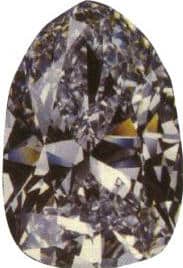
Table 5-6 Overview of Finished Diamonds Cut by Zale Light of Peace
| Nie. | Weight (ct) | Cut Style | Nie. | Weight (ct) | Cut Style |
|---|---|---|---|---|---|
| 1 | 130.27 | Pear | 8 | 1.83 | Pear |
| 2 | 9.11 | Marquise | 9 | 1.55 | Pear |
| 3 | 9.04 | Marquise | 10 | 1.51 | Pear |
| 4 | 6.93 | Round Brilliant | 11 | 1.13 | Pear |
| 5 | 3.63 | Serce | 12 | 0.81 | Marquise |
| 6 | 3.55 | Oval | 13 | 0.37 | Pear |
| 7 | 2.73 | Marquise |
Section III Very Large Diamonds Produced in Lesotho
Lesotho is located in southern Africa. It is a country of magnificent mountains and unique scenery. It is the only country in the world whose entire territory lies above 1,500 m in elevation, earning it the reputation of the “Kingdom in the Sky.” With a land area of only 30,344 square kilometres and surrounded by South Africa, it is the world’s largest “country within a country.” This highland inland nation has rugged peaks and stretches of green pastures, and is therefore also nicknamed the “Switzerland of Africa.”
The Letšeng mine, which yields large diamonds, is located in the Mokhotlong mountains in its northern region at an elevation of 3,200 m. The Letšeng diamond mine is one of the highest-yielding diamond mines in history. The country’s seven superlarge diamonds all came from the Letšeng mine, five of which were discovered in this century.
1. The Lesotho Legend Diamond

2. The Lesotho Promise Diamond
(1) Discovery of the Lesotho Promise Diamond
The Lesotho Promise diamond was discovered on August 22, 2006, at the Letseng diamond mine in Lesotho, weighing 603.00 ct (Fig. 5-41). The then Minister of Natural Resources of Lesotho said, “We named it ‘The Lesotho Promise’ to signify our promise to you that we will find the same or even better diamonds in the future.”

(2) Trade and Cutting of the Lesotho Promise Diamond
This diamond was auctioned in Antwerp, Belgium, on October 9, 2006, and was purchased by the South Africa Diamond Company (SAFDICO), in which the British Graff Diamonds holds a stake, for US$12.4 million. Graff then assembled a 35-person cutting team which, under the guidance of the company’s chief cutter, spent five months conducting detailed analysis and study of the diamond. They successfully and precisely cut and polished the massive rough into 26 D-colour, flawless diamonds: 7 pear shapes, 4 emerald cuts, 13 round brilliants, 1 marquise and 1 heart; the largest of the pears weighed 75 ct, and the smallest was a 0.55 ct round brilliant. That one rough produced 26 D-colour flawless diamonds speaks to the meticulous planning of the cutting team and the precision of their cutting and polishing techniques. The final, extraordinarily rare set of diamonds was named the “Lesotho Necklace” and weighed a total of 223.35 ct (Fig. 5–42). Graff exclaimed, “This is a historic moment; never before has a single diamond been cut into 26 D-colour flawless diamonds!”
At the time, the diamond necklace was estimated to be worth more than US$50 million.
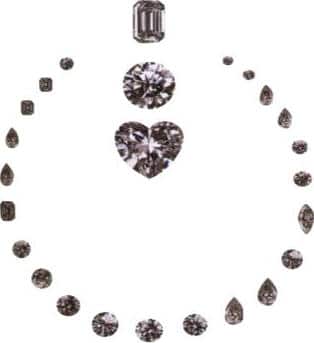
3. The Lesotho Brown Diamond
(1) Discovery and Trade of the Lesotho Brown Diamond
The Lesotho Brown diamond was discovered in 1967 at the Letšeng diamond mine in Lesotho and weighed 601.25 ct (Fig.5-43). The discovery of this diamond marked the beginning of the development of the Letšeng mine, which became known for producing large diamonds. It was reported that the diamond was found by Ms Ernestine Ramoboa, making it the largest diamond in the history of discoveries to have been found by a woman in a primary diamond deposit. The diamond belonged to four members of the family, including her husband, Petrus Ramoboa (Fig.5-44). To sell the diamond and to ensure its safety, Petrus decided to personally carry the diamond on a donkey to the capital, Maseru and deliver it into the safekeeping of a trusted diamond buyer.

Figure 5-43 Lesotho Brown diamond

Figure 5-44 Mr and Mrs Rambeau holding the Lesotho Brown diamond
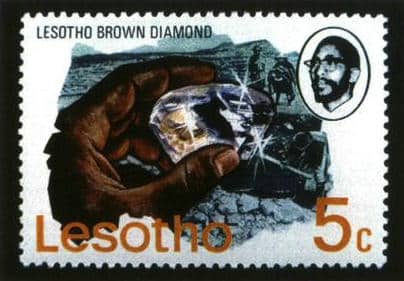
(2) Cutting of the Lesotho Brown Diamond
In 1968, a U.S. television report stated that Harry Winston purchased this diamond and cleaved it in two. The diamond was ultimately cut into 18 finished stones, the largest four weighing 71.73 ct, 60.67 ct, 40.42 ct and 16.35 ct, respectively named Lesotho I, Lesotho II, Lesotho III and Lesotho IV. The largest, Lesotho I, is an emerald-cut diamond, clarity of VVS2, with a slightly pinkish-peach hue (Fig. 5-46). On November 19, 2008, this diamond appeared at a Sotheby’s auction in Geneva with an estimate of 3.36–5.60 million Swiss francs, but it failed to sell.
The Lesotho III is an oval cut (Fig. 5-47). Set by Harry Winston in a platinum ring, it was purchased by Greek shipping magnate Aristotle Onassis and given to Jacqueline Kennedy Onassis, widow of U.S. President Kennedy, as an engagement ring, with an estimated value of $600,000. In April 1996, at the sale of Jacqueline Kennedy’s estate, the auction price for this diamond ring reached $2,587,500.
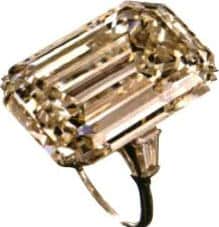
Figure 5-46 Ring set with the Lesotho I diamond

Figure 5-47 Lesotho III diamond
4. Letšeng Star Diamond
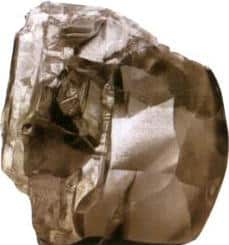
Figure 5–48 The Letšeng Star diamond

Figure 5–49 The 28 polished diamonds cut from the Letšeng Star diamond
5. The Letšeng Legacy Diamond
The Letšeng Legacy diamond was discovered in 2007 at the Letseng diamond mine in Lesotho and weighed 493.00 ct (Fig. 5–50). Its name also reflects praise for the Letseng mine, which is known for producing very large diamonds. The diamond was sold at a diamond auction in Antwerp, Belgium, in November 2007, the diamond was purchased by a South African diamond company controlled by the British company Graff Diamonds for 10.4 million.
After more than a year of careful observation and study of this stone, Graff Diamonds, using top cutting, polishing and setting techniques, successfully transformed the 493 ct rough into a set of three pieces of jewellery that are both elegant and noble. They are: a pair of pear-shaped cuts totalling 132.59 ct as pendant earrings (Fig. 5-51); a diamond ring with a round brilliant as the centre stone flanked by pear-shaped diamonds as side stones, with a total weight of 43.63 ct (Fig. 5-52); and a leaf-shaped diamond brooch set with 15 diamonds of various cuts, with a total diamond weight of 55.61 ct (Fig. 5-53).

Figure 5-50 The Letšeng Legacy Diamond
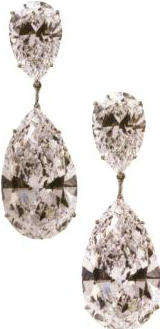
Figure 5-51 Diamond Pendant Earrings
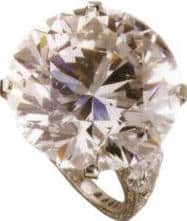
Figure 5-52 Diamond Ring

Figure 5-53 Leaf-shaped Diamond Brooch
6. Leseli la Letšeng Diamond
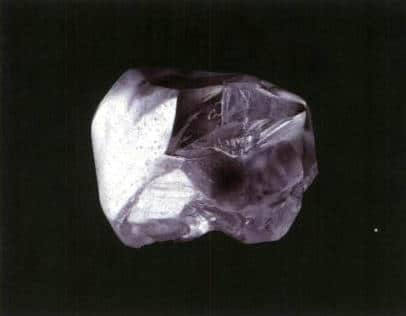
Figure 5-54 The Leseli la Letšeng diamond

Figure 5-55 The Graff Constellation diamond
Copywrite @ Sobling.Jewelry - Producent biżuterii na zamówienie, fabryka biżuterii OEM i ODM
Section IV Extra-Large Diamonds Produced in the Democratic Republic of the Congo
1. Unnamed Diamond
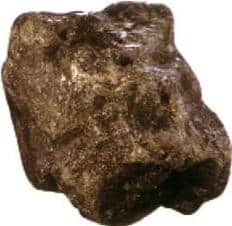
2. The Incomparable Diamond
(1) Discovery of the Incomparable Diamond
The Incomparable diamond (Incomparable) was discovered in 1984 by a little girl among a pile of rubble beside the Mbuji-Mayi diamond mine in the Democratic Republic of the Congo. The rough weighed 890 ct, and after cutting and polishing, the largest finished stone weighed 407.48 ct (Fig. 5-57).
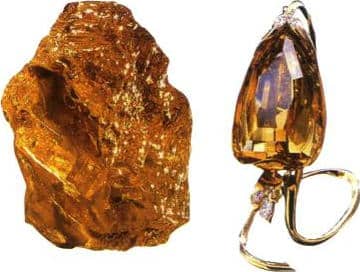
(2) The Owner of the Incomparable Diamond
Philip Oppenheimer, director of De Beers and chairman of the Central Selling Organisation (CSO), sold the diamond to Donald Zale, chairman of the Zale Corporation, who—together with his partners, New York diamond figures Marvin Samuel and Louis Glick—co-owned the stone. In November 1984, the enormous diamond was unveiled at a Zale Corporation anniversary celebration and was subsequently exhibited at the Smithsonian National Museum of Natural History in Washington, D.C.
(3) The Cutting of the Incomparable Diamond
The cutting of the Incomparable diamond was completed under the supervision of Sommeil. Diamond cutter Leo Wins carried out the actual cutting work. Because the rough stone was extremely irregular in shape and its colour distribution very uneven, after four years of study, the diamond was cut into 15 finished stones. The largest of these has a very distinctive cut shape called the Triolette, weighing 407.48 ct. Named the “Incomparable” diamond, its colour is golden yellow; in 1988, GIA graded its clarity as Internally Flawless (IF). It is currently the world’s third-largest finished diamond by weight, after the Golden Jubilee and the Cullinan I. The other 14 diamonds vary widely in colour, from near colourless to distinctly yellow-brown. Their weights are 15.66 ct, 6.01 ct, 5.28 ct, 4.33 ct, 3.45 ct, 3.32 ct, 3.31 ct, 2.74 ct (two stones), 1.99 ct, 1.74 ct, 1.63 ct, 1.52 ct, and 1.33 ct.
(4) The Incomparable Diamond Necklace
In 2013, at the Jewellery and Watch Exhibition held in Doha, Qatar, Fred Mouawad, fourth-generation head of the Mouawad family and son of famed jeweller Robert Mouawad, made a stunning appearance with the Unsurpassed diamond necklace (Fig. 5–58). The necklace consists of 91 diamonds set in rose gold, with a total diamond weight of 637ct, the Incomparable diamond serves as the pendant of this legendary necklace.
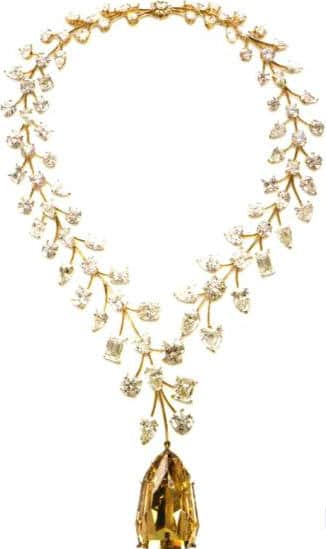
3. Millennium Star Diamond
(1) Discovery of the Millennium Star Diamond
The Millennium Star diamond was discovered in 1990 at the Mbuji-Mayi diamond mine in the Democratic Republic of the Congo, weighing 777 ct.
(2) Cutting of the Millennium Star Diamond
After De Beers purchased this giant diamond, it assembled an international, veteran cutting team whose members came from South Africa, Israel, Belgium, and the United States. Before cutting, the diamond underwent nearly six months of study, and many plastic models identical in shape to the rough were made for simulation experiments during the cutting process. In total, it took three years to complete the task of cutting this giant diamond. After cutting, the diamond weighed 203.04 ct, was fashioned as a pear-shaped cut (Fig. 5-59) with a total of 54 facets, had a colour grade of D, and reached Internally Flawless (IF) clarity. Mr Harry Oppenheimer, former chairman of De Beers, once described this diamond as the most beautiful diamond he had ever seen.
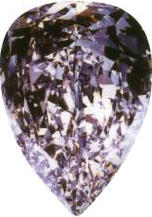
(3) “Millennium Diamonds” Exhibition
On September 8, 1999, De Beers decided to hold an exhibition at the Millennium Dome in London for a group of diamonds named the “Millennium Diamonds” to welcome the new millennium. Nicky Oppenheimer (son of Harry Oppenheimer), then chairman of De Beers, said: “The ‘Millennium Diamonds’ series is so rare and precious; it is the best gift to present to the new millennium.”
The “Millennium Star” diamond is one of the most important exhibits in this “Millennium Diamonds” series exhibition. In addition, there are 11 blue diamonds from the Premier mine in South Africa, cut into various shapes blue diamonds (Fig. 5–60), weighing 5.16~27.64ct, among which the largest one weighs 27.64 ct, is heart-shaped, and is named the “Heart of Eternity.” De Beers invited the famous French film star Sophie Marceau to attend the unveiling of the “Millennium Diamonds.” When she held the “Millennium Star” diamond in her hand, she nearly fainted and exclaimed, “It’s so beautiful.”
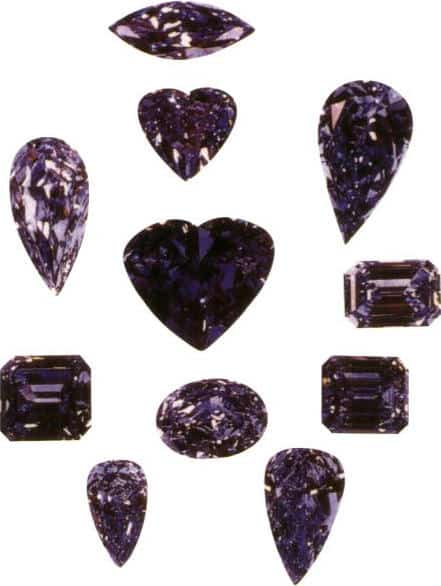
Section V Very Large Diamonds Produced by other African Countries
1. Very Large Diamonds Produced by the Central African Republic

2. Extra-Large Diamonds Produced in Angola

After 11 months of research and evaluation, the diamond was finally cut into a single 163.41 ct emerald-cut diamond (Fig. 5–63), which the GIA certified as a Type IIa diamond, colour D and flawless (FL) clarity.
De Grisogono specially designed an asymmetric platinum necklace for this diamond, called The Art of de Grisogono. The pendant on that necklace is the 163.41 ct emerald-cut diamond, set with four prongs, each prong set with a long step-cut diamond to make the main stone’s fire more vivid and bright; one side of the necklace is composed of 18 graduated long step-cut diamonds, while the other side suspends 66 pear-shaped emeralds, creating a striking contrast with the main diamond (Fig. 5–64).
It is worth mentioning that the back of the pendant hides a detachable mechanism that allows the 163.41 ct diamond to be removed and worn as a bracelet, crown, or brooch. The entire piece took as long as 1,700 hours to create.
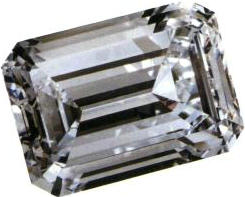
Figure 5-63 4 de Fevereiro diamond (II)

Figure 5-64 The Art of de Grisogono
Section VI Extra-Large Diamonds Produced in Brazil
1. The President Vargas Diamond
(1) Discovery of the President Vargas Diamond
The President Vargas diamond, the rough stone measuring approximately 56mm×51mm×24mm, weighed 726.60 ct. It was discovered on August 13, 1938, in the San Antonio River in the Coromandel district of Minas Gerais, Brazil. It was found on the riverbed by Joaquim Venancio Tiago and Manoel Miguel Domingues, and is the largest diamond discovered in Brazil to date. The diamond was named after the then-President of Brazil, Getulio Dornelles Vargas.
(2) Transactions Involving the Rough President Vargas Diamond
The discoverers of the diamond were eager to sell it; they sold it to a diamond broker for $56,000, and the broker resold the diamond for $235,000. Eventually, the Dutch Union Bank in Amsterdam purchased the diamond. The diamond was taken to the Netherlands and stored in the Dutch Union Bank’s vault. When the famous American jeweller Harry Winston learned of this, he hurried to Amsterdam to negotiate with the diamond’s owner and bought the diamond. At the British insurance company Lloyds, the diamond was insured for $750,000 and, using ordinary registered mail with 75 cents postage, was sent to the company’s headquarters in New York.
(3) Cutting of the President Vargas Diamond
After Harry Winston became the new owner of the diamond, he organised a special diamond-cutting team and spent several months studying the rough diamond, it was decided to cleave it into multiple pieces to obtain high-quality finished diamonds. The cutting and polishing work began in 1941, first sawing off a 20 ct rough diamond from the stone and processing it into one high-quality pear-shaped diamond weighing 10.05ct. Ultimately, this diamond was cut into 29 finished stones, of which 16 were emerald cuts, 10 were trilliant cuts, and one each pear, marquise, and cushion. The total weight of the finished diamonds was 411.06 ct, and the yield was 56.57%. The largest of these weighed 48.26 ct, was emerald cut, and was still named the “President Vargas” diamond.
(4) Transactions after Cutting and Polishing of the President Vargas Diamond
In 1944, Harry Winston sold the President Vargas diamond to a wealthy businessman in Fort Worth, Texas. Later, in 1958, it was repurchased and reworked again, reducing its weight to 44.17 ct, but improving its clarity to Internally Flawless (IF), and in 1961, it was sold again to an anonymous collector. Currently, the diamond is part of the collection of the famous jeweller Robert Mouawad. At the Sotheby’s auction in New York in April 1989, he also bought the President Vargas IV diamond, weighing 27.33 ct, for $781,000. The President Vargas VI diamond, weighing 25.4 ct, was sold at Sotheby’s in New York in October 1992 for $396,000.
2. Other Very Large Diamonds Produced in Brazil
(1) Darcy Vargas Diamond
The Darcy Vargas diamond, discovered on July 8, 1939, was found in the São Antônio River in the Coromandel district of Minas Gerais, Brazil, just 2 km from the site where the Vargas President diamond was found. The diamond is named after Darcy Vargas, the wife of then-president Getúlio Dornelles Vargas. The rough stone was irregular in shape, weighed 455 ct, and was brown in colour. In the early 1940s, it was exhibited in New Haven, Connecticut, USA.
(2) Charncca I Diamond
The Charncca I diamond was discovered in 1940 in the Santo Inácio River in the Coromandel district of Minas Gerais, Brazil, and weighed 428 ct.
(3) President Dutra Diamond
The President Dutra diamond, 1949, was found in the Dourados River in the Abadia district of Minas Gerais, Brazil by a local farmer. The diamond’s name comes from then-Brazilian President Eurico Gaspar Dutra (Eurico Gaspar Dutra). The rough stone weighed 407.68 ct. It was cut into 36 finished diamonds with a total weight of 136 ct, yielding a material recovery rate of 33.36%. The largest finished diamond weighs 9.60 ct and is still called the President Dutra Diamond; the smallest weighs 0.55 ct.
(4) Coromandel VI Diamond
The Coromandel VI diamond, discovered in 1948 in the Coromandel district of Minas Gerais, Brazil, weighs 400.65 ct.
Section VII Extra-Large Diamonds Produced in India
1. The Great Mughal Diamond
(1) The Past Life of the Great Mogul Diamond
The Great Mogul diamond was discovered in India and has a long history. The diamond was named by the Mughal dynasty ruler Akbar; during 1656–1657, Shah Jahan of the Mughal dynasty came into possession of it. At that time, it was the largest diamond known to have been found in the world. In November 1665, the famous French jeweller and traveller Jean Baptiste Tavernier (Figure 5–65), at the invitation of the Mughal dynasty’s sixth emperor, Aurangzeb, was permitted to examine and test (including weighing) the diamond. Unfortunately, after Tavernier examined the stone, all traces of it suddenly disappeared. According to Tavernier’s description, the diamond’s size was similar to a small egg, while its shape was like a half-egg (Figure 5–66).
Tavoni once carefully examined the Great Mogul diamond, and he recorded: “The first diamond placed in my hand was a large stone cut into a round rose shape. On one side of the diamond there is a small notch, and internally there is an inclusion; the diamond is of high-quality water (color)…”
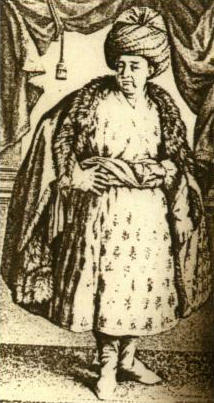
Figure 5-65 Jean Baptiste Tavernier

Figure 5-66 Cut diagram of the Great Mogul diamond
(2) The Present Form of the Great Mogul Diamond
After that, the diamond passed through the hands of several rulers of the Mughal dynasty. The Soviet mineralogist E. A. Fersman once thought the Great Mogul diamond was the famous Koh-i-Noor, and later believed it was the Dayya-i-Noor diamond belonging to the Iranian royal family, but that was not the case. Some thought the missing Great Mogul diamond was the Orloff diamond, but that can only be speculation.
The Great Mogul diamond, the Koh-i-Noor, and the Orloff are only similar in shape; in essence, they are three different diamonds, with obvious differences in weight. In that era, Tavoni was recognised as a diamond merchant with extensive knowledge of diamonds; his descriptions and records of diamonds are reliable. As a diamond merchant, he was extremely sensitive to a diamond’s weight and would not be mistaken about it.
Tavoni believed that when the Great Mogul diamond came into the hands of Shah Jahan, the rough stone weighed 900 ratis, equivalent to 787.50 ct. However, when Tavoni saw the diamond, it had already been cut by the Venetian diamond cutter Hortensio Borgio, and its weight had been reduced to only 319.5 ratis, equivalent to 280 ct. The Koh-i-Noor’s weight is 186 ct, and the Orloff’s weight is 193 ct; the weight differences among the three diamonds are clear. Borgio’s poor workmanship caused the diamond to lose too much weight; the king of Oran not only did not pay him his fee, but fined him 10,000 rupees, which was all the money Borgio had with him; otherwise, he would have been fined even more.
Borgio was a cutter of limited skill; Tavoni believed his understanding and study of diamonds were not thorough. If he had been able to cleave a large piece off the rough along the stone’s cleavage planes, he would not have created so many problems in the subsequent cutting and polishing, and perhaps he would have earned the wages that were due him. Although Indian diamond cutters at the time could cleave and cut diamonds, the traditional Indian polishing techniques were inferior, which may have been the reason they commissioned the European cutter Borgio for the job.
2. The Nizam Diamond
3. The Pitt Diamond
(1) The Discovery of the Pitt Diamond
The Pitt diamond was discovered in 1701 by a miner working at the Partial diamond mine on the Krishna River in Golconda, India; the rough stone weighed 410ct. The miner who found the diamond did not want to hand it over and attempted to flee with it. To conceal it, he wounded his own calf and hid the diamond under the bandaged dressing, eluding strict supervision and escaping to the coast. He confided the secret to a British captain anchored there and proposed to share the proceeds of the diamond’s sale on the condition that the captain take him out of the country. The captain feigned agreement, but during the voyage, he secretly took the diamond and threw the discoverer into the vast sea.
(2) The Trade and Cutting of the Pitt Diamond
It is said the captain sold the diamond to the merchant Jamchund for £1,000. Later, Thomas Pitt, Governor of Madras, bought the diamond for £24,000 and named it the Pitt diamond. The diamond was shipped to London on the merchant ship Bedford. In London, the stone was recut by Joseph Cope, reducing its weight from 410 ct to 400.5 ct; the cutting cost £5,000, a considerable sum in the early 18th century. After cutting, a small inclusion remained on the surface, which could be concealed by mounting, and two internal flaws were difficult to see with the naked eye.
Subsequently, the Pitt diamond was recut again. After recutting, the weight was reduced to only 140.50ct, fashioned into a cushion cut, measuring approximately 32mm×34mm×25mm; the cutting took nearly two years and cost $25,000. The smaller diamonds produced in the cutting were sold for $35,000, and some of the rose-cut stones were bought by Peter the Great of Russia. The recut Pitt diamond became a high-quality brilliant-cut gem. Its price was steep, making it difficult to sell, while at the same time, the public was eager to see this incomparable treasure, spurring countless legends. Pitt was therefore very worried about theft and kept the diamond on his person at all times, frequently changing his residence for security. In short, the diamond exhausted Pitt, and anxious to rid himself of the burden, he hurried to sell it, even making a lead model of the stone. The high price put off many European royals; Louis XIV of France, a jewellery lover, lacked the funds to purchase the rare gem. After Louis XIV’s death, his five-year-old great-grandson ascended the French throne, with Philippe II, Duke of Orléans, acting as regent. To display his power, he paid £135,000 for the diamond and renamed it the Regent Diamond (Fig. 5-67). Pitt paid a £5,000 commission to sell the stone, and the successful transaction relieved him of his heavy psychological burden.

(3) History of the Regent Diamond
In 1772, at the coronation of Louis XV, the Regent Diamond was set in his crown. The queen, Leszczyńska, also frequently wore this diamond. In 1792, the Regent Diamond, along with other jewels of the French royal family, including the Mirror of Portugal diamond, the Sancy diamond, and others, was stolen; after more than a year, the Regent Diamond was found in a crack in the attic of a timber-framed house in Paris. Thus, the diamond returned to the French royal treasure. The Regent Diamond is a beautiful, high-quality diamond.
In 1799, Napoleon Bonaparte proclaimed himself First Consul, and the French crown jewels were used as collateral for various fundraisings. Officers in Napoleon’s army personally pawned many diamonds, including the Regent Diamond and the famous Sancy Diamond, obtaining the necessary loans from Berlin and Madrid, respectively.
The armies led by Napoleon conquered Italy and brought back large quantities of precious metals and gemstones, and France’s treasure trove began to grow again. Napoleon also redeemed most of the diamonds that had been pawned or mortgaged, including the RégentRégent Diamond; he set this diamond into the guard of a sword, alongside two diamonds of about 16.5 ct each. In 1804, after Napoleon declared himself Emperor, he wore a crown once worn by the Virgin Mary and carried a sceptre set with the RégentRégent Diamond at his coronation.
After a series of wars, Napoleon controlled much of Europe. He divorced Josephine and married Marie Louise. For their wedding, France purchased a large amount of jewellery. Afterwards, the sword bearing the Regent Diamond was dismantled and the diamond was mounted on a newly made sword, surrounded by rose-cut diamonds and other stones. Napoleon rebuilt a considerably rich jewellery collection for France, which, after the accession of Louis XVIII, once again became known as the French crown jewels. At the Battle of Waterloo, Napoleon was defeated, and subsequently, Charles X set the Regent Diamond into the crown.
Thereafter, the French crown jewels remained relatively undisturbed for a time. In 1848, the French Second Republic was established, but the royal jewels were not destroyed. When Napoleon III married Eugénie, France’s jewellery collection was quite abundant; the royal jewellers Messrs Bapst designed a new crown for Empress Eugénie, which was set with the Regent Diamond.
After the establishment of the French Third Republic, at the end of 1886, on the proposal of Benjamin Raspail, a decision was made to entrust jewels of historical, scientific, and artistic value respectively to the Natural History Museum, the School of Mines, and the Louvre, and to sell the remainder by public auction. This decision was disastrous for the long-standing French royal jewels; besides economic reasons, there were perhaps political motives as well — namely, to eradicate the power and symbols of the French Empire.
From May 12 to 23, 1883, the French royal jewellery was publicly auctioned, jewellers from around the world competing to bid. A total of 54,403 brilliant-cut diamonds, 21,119 rose-cut diamonds, 2,963 pearls, 507 rubies, 312 emeralds and 136 sapphires were sold, most of which were acquired by Tiffany of New York; fortunately, the Regent Prince’s diamonds—because of their high historical value—were not included on the auction list.
During World War II, the German army occupied France. Before the fall of Paris in 1940, the French government hid the Regent Diamond behind an inconspicuous panel in the Château de Chambord on the banks of the Loire. Reichsmarschall Göring threatened by force, demanding the diamond, but did not succeed. In 1945, the Regent Diamond returned to the Apollo Gallery of the Louvre. In January 1962, at the centennial exhibition of French jewellery held at the Louvre, the Regent Diamond was displayed together with the Sancy Diamond and the Hope Diamond — their first “reunion” since they were stolen from the French crown jewels in 1792.
Section VIII Extra-Large Diamonds Produced in Canada






